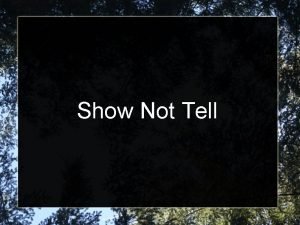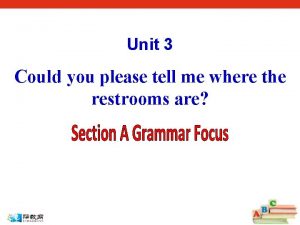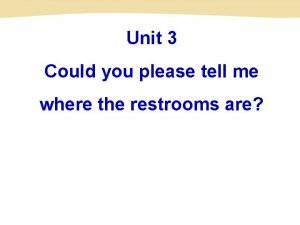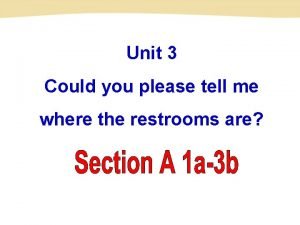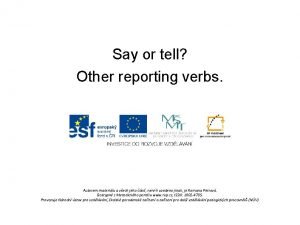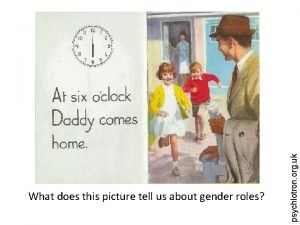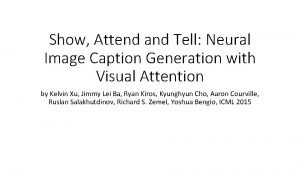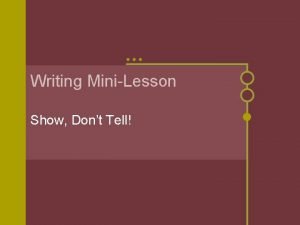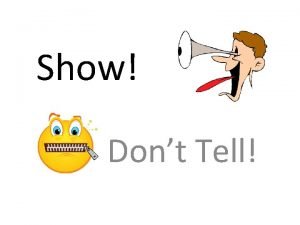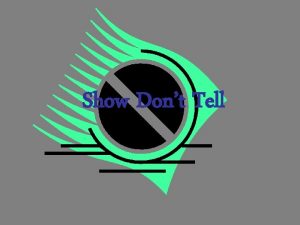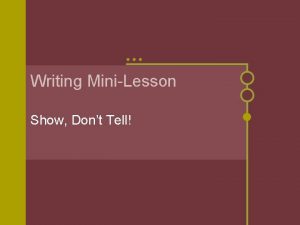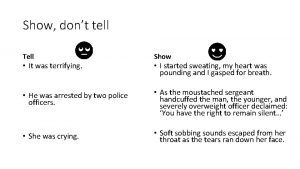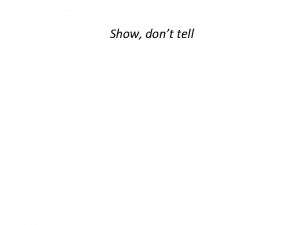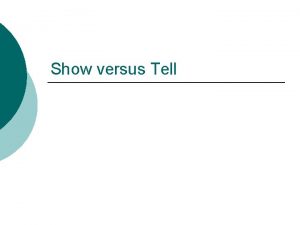Show versus Tell Show versus Tell Please shut












- Slides: 12

Show versus Tell

Show versus Tell ¡ ¡ ¡ Please shut your eyes while I read this sentence to you: Mavis was angry when she heard what the umpire said. What does that look like?

Show versus Tell ¡ Please shut your eyes again and listen to this sentence: ¡ Shaking her head back and forth, Mavis pounded home plate with her fist after the umpire shouted, “You’re out!” ¡ Now what picture do you have in your head?

Strategies writers use to SHOW what is happening include: l l l describing the character’s actions rather than just saying how he or she feels using action verbs using precise nouns and active verbs with strong modifiers (adjectives, adverbs, phrases and clauses) using similes, metaphors and personification using dialogue appealing to some of the five senses to paint a picture of what is happening

Word Choice “The difference between any word and the right word is the difference between the lightning bug and the lightning. ” - Mark Twain The exact word means that you convey precisely what you, the writer, want the reader to see and you do it in a way that is fresh, clean, concise, and accurate. Why choose the word crimson over red ? Why furious over angry? Is your cat orange or is he pumpkincolored? Did the wind blow or did it slap? Did the river run or roar?

Turning the abstract to concrete Telling: This is really generalized language; this is the writer telling me what a sick woman is. I can’t see this image. I can’t visualize “lively” or “symptoms of illness” or her “not herself. ” Showing: Now this is a specific sick woman. Now I can see her. I can start to understand her specific illness. And remember, you can alter the details to convey a specific kind of sick: perhaps she’s vomiting; maybe her face is red with fever. Those are the kinds of details that make the writing stand out.

Which is better? a. b. Papers overflowed my cramped desk as I rummaged for the pencil I knew was buried somewhere inside its dark depths. My desk is a mess.

Which is better? • • I am cold. My teeth chattered as I blew warm breath on my numb fingers.

Which is better? a. b. The broken windows and creaking hinges made me tremble as I slowly crossed the shadowed yard towards the dilapidated house. I was scared as I walked towards the haunted house.

Practice ¡ ¡ Tell - The mall is crowded in December. I live on a very busy street.

Revisions ¡ In revision, test yourself based on these Showing vs. Telling principles: l l Can I close my eyes and see what I’m trying to convey? Check those words: Can they be more fresh and vivid? Are they too general – can they be more specific and particular?

Sources ¡ ¡ ¡ www. vanderbilt. edu/hpao/. . . /Show%20 don't%20 tell%20 AMCAS. ppt www. mce. k 12 tn. net/english/Show, %20 Don't%20 Tell. ppt www. misscantillon. com/Class%20 Notes/show, don'ttell. ppt
 How to show and not tell
How to show and not tell Will you please be quiet please raymond carver
Will you please be quiet please raymond carver Would you please tell me where the mall is
Would you please tell me where the mall is Could you please tell me where
Could you please tell me where Excuse me could you tell me the way to the national museum
Excuse me could you tell me the way to the national museum Excuse me . could you tell me
Excuse me . could you tell me Can you please tell me some information that
Can you please tell me some information that Say versus tell
Say versus tell Tell me what you eat and i shall tell you what you are
Tell me what you eat and i shall tell you what you are What does the picture tell or show
What does the picture tell or show Show and tell a neural image caption generator
Show and tell a neural image caption generator Confucius tell me and i will forget
Confucius tell me and i will forget Show don't tell
Show don't tell
